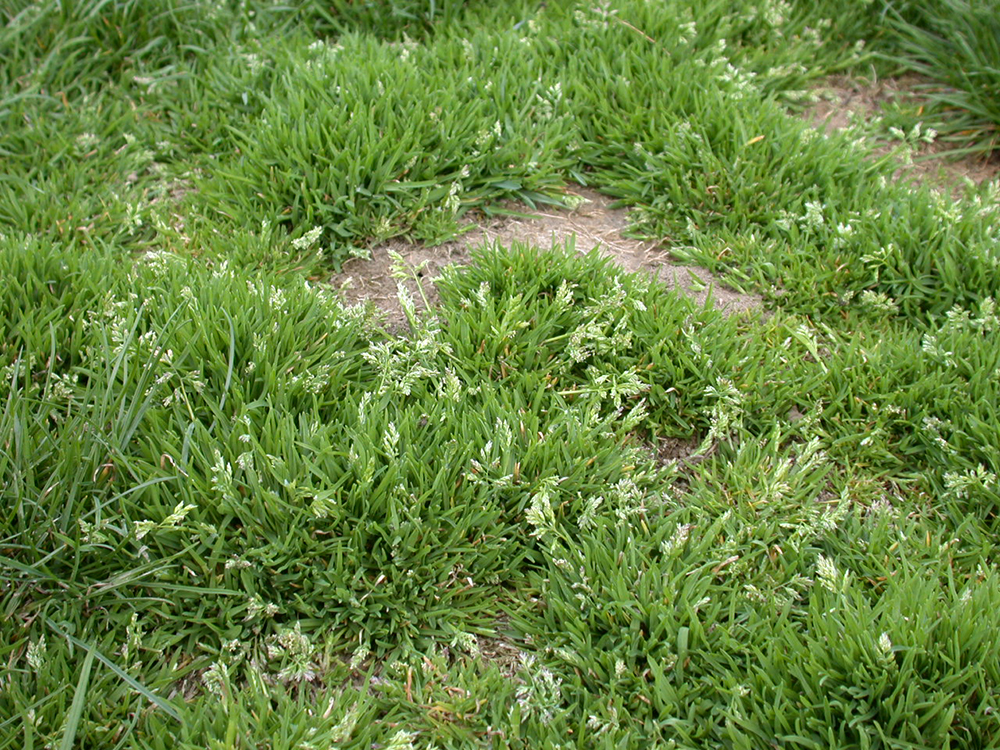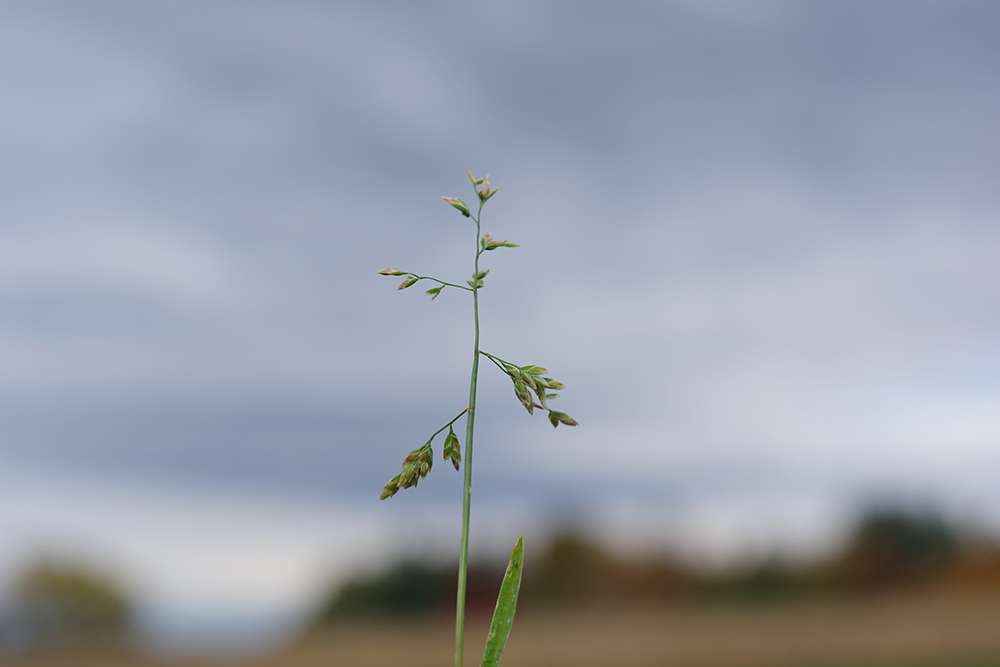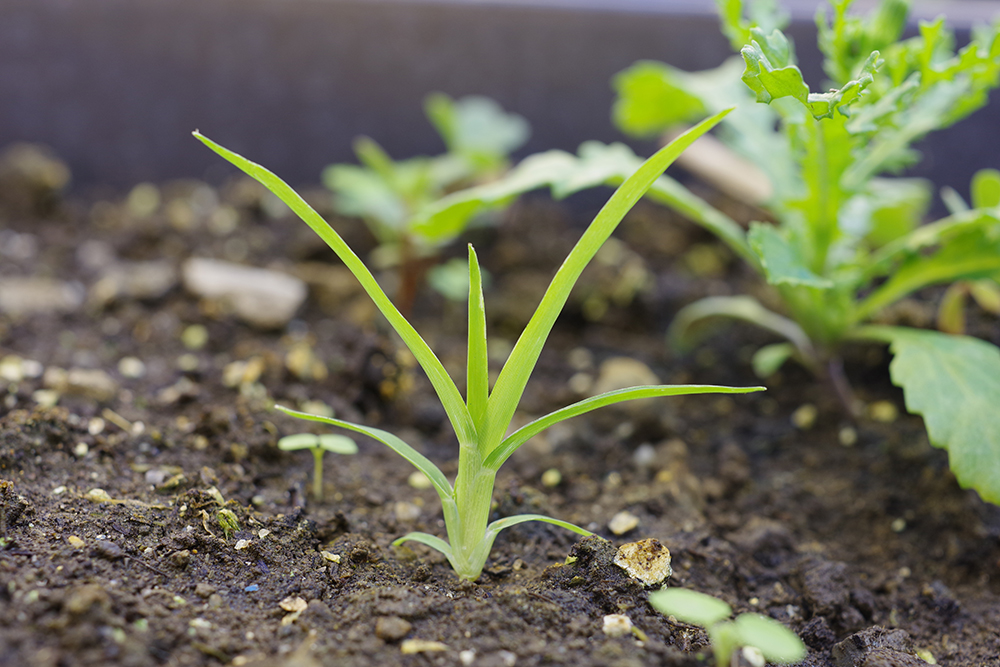Other common names: low speargrass, six-weeks grass, annual meadowgrass, annual spear grass, dwarf spear grass, dwarf meadow grass, causeway grass, speargrass, poanna



Poa annua L.
Identification of Annual Bluegrass
Family: Grass family, Poaceae
Habit: Short winter or summer annual bunchgrass, sometimes surviving through a second growing season. Two major variants have been identified, P. annua var. annua, an annual with an erect habit, and P. annua var. reptans, a short-lived perennial with a prostrate growth habit. The perennial variants are more common in turfgrass than are the annual variants. Perennial variants survive by growing roots from stem nodes in contrast with perennial Poa turfgrasses which spread by rhizomes.
Description: The linear seedling leaf (0.2–0.35 inch long by 0.04–0.1 inch wide) emerges perpendicular to the ground. Young true leaves unfold from the bud into a V with a tip shaped like a boat prow; they lack auricles and have 0.1–0.2 inch long, translucent, slightly pointed ligules. Collar regions are green and hairless. Light green blades are 0.75–2 inches long by less than 0.04–0.1 inch wide, crinkled or wavy on the surface, and smooth edged. Blades may be hairless or have scattered soft hairs. Hairless, flattened sheaths open down the stem.
Mature plants grow into 1- to 12-inch tall, highly tillering, upright or prostrate clumps. Stems are bright green to yellow green. Sheaths open nearly to the base and easily pull away from the stem. Sheaths are transparent and pale, hairless, V-shaped and without auricles; mature leaves have a ligule similar to that of seedling leaves. Blades are light green, linear, 0.5–5.5 inches long by 0.1 inch wide, nearly hairless, with the distinctive boat prow-shaped tip. The root system is shallow, fibrous and matting. Spontaneous rooting occurs at tiller bases. Numerous 1- to 3-inch tall, pyramid shaped inflorescences develop. White-green immature seedheads are open or airy, with several small flower clusters (spikelets) loosely grouped at the ends of branches within the pyramid. Individual spikelets are 0.2 inch long and contain two to six flowers. As with other grasses, the apparent seed includes a thin, tightly adhering layer of fruit tissue. Yellow-gray seeds are 0.1 inch long, elliptical and with one blunt end.
Similar species: Three perennial bluegrass species resemble annual bluegrass. Canada bluegrass (Poa compressa L.) is 1–2 feet tall, has flat, wiry stems and narrow, blue-green blades. Kentucky bluegrass (Poa pratensis L.) is 1–3.25 feet tall, with dark green leaves 2–30 inches long. It is a coarser looking plant whose inflorescences consistently have a whorl of two to five small branches at the base. Roughstalk bluegrass (Poa trivialis L.) is 1–3 feet tall, with yellow-green leaves 1–8 inches long. Leaves are rough and folded in the bud, with a large tapering membranous ligule. Italian ryegrass [Lolium perenne L. ssp. multiflorum (Lam.) Husnot] resembles annual bluegrass but can be distinguished by its long, narrow auricles.
Management of Annual Bluegrass
Annual bluegrass can be a severe problem in turfgrass. In agriculture it is primarily a problem in vegetables and small grain crops. Close mowing shifts the population in grassy areas to the creeping perennial form that is more easily controlled by tillage when it invades tilled fields. If annual bluegrass is abundant at the time of spring tillage, use a moldboard plow to invert the soil, which will bury the plants and kill them. Subsequent shallow secondary tillage should rely on disks or harrows to avoid bringing clumps back to the soil surface. Rotary tillage is not recommended as it will leave many clumps only partially buried. These will have a good head start on your crop and may cause problems if the crop is not highly competitive.
Severe infestations are usually the result of leaving soil undisturbed from late summer/early fall through the spring. In this situation, a few plants can produce many seeds before late spring tillage, and the large clumps are likely to survive tillage. To prevent problems with annual bluegrass the following year, till seedlings under late in the fall after most have germinated and then plant a winter cereal cover crop at high density to compete with late emerging individuals. When cultivating to destroy young annual bluegrass, burial is more effective than uprooting since this weed is very good at rerooting. Cultivating annual bluegrass after it forms clumps is not effective unless performed in very hot and dry conditions.
In pastures, annual bluegrass usually indicates over grazing or excessive trampling. It tends to invade where other grasses have died or been damaged rather than displacing them by competition.
Ecology of Annual Bluegrass
Origin and distribution: Annual bluegrass originated in southern Europe and has been introduced into more than 80 countries in North Africa, North Asia, Australia, North and South America, and even Antarctica. It is a weed of temperate and subarctic climates and occurs in the tropics only at high elevations.
Seed weight: Mean seed weights from field grown plants range from 0.19–0.48 mg, though seed weights as high as 0.59 mg have been observed from greenhouse grown plants.
Dormancy and germination: Annual bluegrass produces both dormant and non-dormant seeds. The proportion of dormant seeds varies between populations and is affected by conditions during seed set. For example, a dormant Louisiana population that required warm temperatures to break dormancy functioned as a winter annual, whereas non-dormant Wisconsin populations functioned as summer annuals. Annual forms generally have a higher percentage of dormant seeds while perennial types have minimal dormancy. Dormancy declines over a period of months. Thus, non-dormant seeds produced in the spring germinate in the summer, whereas the dormant seeds are ready for germination by fall. Dormant seeds collected in Louisiana required moist heat to break dormancy whereas seeds from Australia required chilling. A few seeds can germinate at temperatures as low as 36–41°F, but high germination percentages require temperatures of 41–68°F. In ecotypes from Alabama, germination was best at 66/50°F (day/night) and declined at higher temperatures. Temperatures over 86°F decrease germination of non-dormant seeds and can reduce viability of dormant seeds. Many seeds that get incorporated into the soil before germination (for example, if they are cultivated into dry soil) become dormant and require specific environmental cues to stimulate germination. For such seeds, germination is stimulated by light, fluctuation in day/night temperatures and the presence of nitrate. Germination is reduced in dry conditions more so than for other winter annual grass species. In the coastal area of central California, long day length in the spring was hypothesized to contribute to inducing dormancy in spring and early summer, whereas shortening day length was hypothesized to contribute to decreasing dormancy in fall and early winter.
Seed longevity: Few seeds of annual bluegrass survive in the soil longer than five years. In soil stirred four times per year, seed density declined by 26% per year, and in undisturbed soil, it declined by 22% per year. In another study, seed mortality was 29–50% per year in frequently disturbed soil and 17–26% per year in undisturbed soil.
Season of emergence: Most emergence occurs in the late summer and fall, but some emergence occurs during spring and summer.
Emergence depth: This does not appear to have been studied, but given the small seed size, most seeds probably emerge from the top 1 inch of soil.
Photosynthetic pathway: C3
Sensitivity to frost: Annual bluegrass tolerates frost well. Exposed, fully frozen plants will die in about two weeks, but the species commonly overwinters under snow or in the shelter of cover crops or crop residue.
Drought tolerance: Annual bluegrass is intolerant of drought and high soil temperatures. Plant leaf length, tillering and mass were greater when grown at 72°F than when grown at 90°F. Plants, however, can tolerate short exposure to high air temperatures, with plants surviving a 3-hour exposure to 117°F.
Mycorrhiza: Annual bluegrass is mycorrhizal.
Response to fertility: Annual bluegrass size responds directly to the amount of N, P or K applied. Nitrogen favors leaf production, whereas P and K promote seed production. However, herbage growth also increases with increasing levels of P and K. It grows best on soils with pH from 5.5–6.5 and is only rarely found on soils with pH less than 5.3.
Soil physical requirements: Annual bluegrass can grow in different types of soils, from clays to sands. It tolerates extreme compaction and waterlogged conditions. Fine textured soils that maintain higher water content in winter tend to have higher annual bluegrass populations than sandier, well drained soils.
Response to shade: The species grows well in moderate shade, and it often thrives under trees and in pastures and hay meadows dominated by taller grasses. It can sustain vegetative and reproductive growth at 80–92% shade, explaining its common occurrence in fields of highly competitive cereal crops. It is associated with shaded cracks in sidewalks.
Sensitivity to disturbance: Annual bluegrass is difficult to uproot with hoes and cultivators because part of the spreading root system often remains in the ground. The dense roots hold soil and allow uprooted plants to survive and quickly reroot. Once the plants have made side shoots (tillers), this species is among the hardest weeds to kill by uprooting. It is very tolerant of trampling, and it will flower and set seed when kept mowed to a height of 0.25 inch.
Time from emergence to reproduction: Overwintering plants begin growth in the very early spring and flower almost immediately. Peak seed production occurs in May to early June but also can occur throughout the year. Cold vernalization accelerated heading, which occurred at the 11-leaf stage with vernalization and 15-leaf stage without vernalization. Spring germinating plants of the annual form set seeds in 44–55 days, whereas the perennial form required 81–93 days. Shade may delay time to first flowering by up to 20 days. Cut flowering panicles can still produce viable seeds, suggesting that seeds mature quickly.
Pollination: Annual bluegrass primarily self-pollinates but occasionally cross-pollinates by wind dispersed pollen.
Reproduction: Annual bluegrass plants typically produce 1,050–2,250 seeds per plant. In a British study, annual bluegrass produced about 80 seeds per stalk when the plants were grown at low density. Pasture populations dominated by the perennial form averaged 30 seed stalks per plant in the first year and 450 the second. Populations from a mixture of other sites dominated by the annual form averaged 100 seed stalks per plant the first year and 180 in the second. Under ideal conditions, seed production could exceed 20,000 seeds per plant. In the perennial form of the species, the prostrate stems root at the nodes. The stems then decompose over the winter so that this form of the plant has true vegetative reproduction.
Dispersal: Annual bluegrass disperses short distances by rain wash and wind. People, however, contribute most to the dispersal between fields and farms. The seeds stick readily to wet shoes, tires and mowing machinery, and since seeds often reach high density in soil, they probably also frequently disperse in soil clinging to tillage and cultivation machinery. Mowing can be an important factor dispersing this species. Seeds also pass through cattle and are spread with the manure. Birds may occasionally disperse the seeds.
Common natural enemies: Bluegrass billbug larvae (Calendra parvulus) eat the rootlets. Several species of Carambus moth, including the bluegrass webworm (C. teterellus) attack annual bluegrass; many fungal diseases also attack it. Large earthworms eat annual bluegrass seeds and digest about 70% of what they consume (Hutchinson and Seymour 1982).
Palatability: People do not eat any part of annual bluegrass. Livestock, however, find it highly palatable.
Note: Annual bluegrass pollen causes hay fever symptoms in many people.
Weed Characteristics Summary Table of Annual Bluegrass
| Annual bluegrass | ||||||||
|---|---|---|---|---|---|---|---|---|
| Growth habit | Seed weight (mg) | Seed dormancy at shedding | Factors breaking dormancy | Optimum temperature for germination (F) | Seed mortality in untilled soil (%/year) | Seed mortality in tilled soil (%/year) | Typical emergence season | Optimum emergence depth (inches) |
| short, erect to prostrate | 0.19–0.48 | Variable | cms, wst, li, at, ni | 41–68 | 17–26 | 26–50 | late summer to fall, spring | 0–1 |
| Photosynthesis type | Frost tolerance | Drought tolerance | Mycorrhiza | Response to nutrients | Emergence to flowering (weeks) | Flowering to viable seed (weeks) | Pollination | Typical & high seed production (seeds per plant) |
| C3 | high | low | yes | high | 1–8 | 1–2 | self, can cross | 2,000 & 20,000 |
Table Key
General: The designation “–” signifies that data is not available or the category is not applicable.
Growth habit: A two-word description; the first word indicates relative height (tall, medium, short, prostrate) and second word indicates degree of branching (erect, branching, vining).
Seed weight: Range of reported values in units of “mg per seed.”
Seed dormancy at shedding: “Yes” if most seeds are dormant when shed, “Variable” if dormancy is highly variable, “No” if most seeds are not dormant.
Factors breaking dormancy: The principle factors that are reported to break dormancy and facilitate germination. The order of listing does not imply order of importance. Abbreviations are:
scd = seed coat deterioration
cms = a period subjected to cold, moist soil conditions
wst = warm soil temperatures
li = light
at = alternating day-night temperatures
ni = nitrates
Optimum temperature range for germination: Temperature (Fahrenheit) range that provides for optimum germination of non-dormant seeds. Germination at lower percentages can occur outside of this range. The dash refers to temperature range, and the slash refers to alternating day/night temperature amplitudes.
Seed mortality in untilled soil: Range of mortality estimates (percentage of seed mortality in one year) for buried seeds in untilled soil. Values were chosen where possible for seeds placed at depths below the emergence depth for the species and left undisturbed until assessment. Mortality primarily represents seed deterioration in soil.
Seed mortality in tilled soil: Range of mortality estimates (percentage of seed mortality in one year) for seeds in tilled soil. Values were chosen for seeds placed within the tillage depth and subjected to at least annual tillage events. Seed losses are the result of dormancy-breaking cues induced by tillage, germination and deterioration of un-germinated seeds.
Typical emergence season: Time of year when most emergence occurs in the typical regions of occurrence for each weed. Some emergence may occur outside of this range.
Optimum emergence depth: Soil depths (in inches below the soil surface) from which most seedlings emerge. Lower rates of emergence usually will occur at depths just above or just below this range.
Photosynthesis type: Codes “C3” or “C4” refer to the metabolic pathway for fixing carbon dioxide during photosynthesis. Generally, C3 plants function better in cooler seasons or environments and C4 plants function better in warmer seasons or environments.
Frost tolerance: Relative tolerance of plants to freezing temperatures (high, moderate, low).
Drought tolerance: Relative tolerance of plants to drought (high, moderate, low).
Mycorrhiza: Presence of mycorrhizal fungi. “Yes” if present; “no” if documented not to be present, “unclear” if there are reports of both presence and absence; “variable” if the weed can function either with or without, depending on the soil environment.
Response to nutrients: Relative plant growth response to the nutrient content of soil, primarily N, P, K (high, moderate, low).
Emergence to flowering: Length of time (weeks) after emergence for plants to begin flowering given typical emergence in the region of occurrence. For species emerging in fall, “emergence to flowering” means time from resumption of growth in spring to first flowering.
Flowering to viable seed: Length of time (weeks) after flowering for seeds to become viable.
Pollination: “Self” refers to species that exclusively self-pollinate, “cross” refers to species that exclusively cross-pollinate, “self, can cross” refer to species that primarily self-pollinate, but also cross-pollinate at a low rate, and “both” refers to species that both self-pollinate and cross-pollinate at relatively similar rates.
Typical and high seed production potential: The first value is seed production (seeds per plant) under typical conditions with crop and weed competition. The second value, high seed production, refers to conditions of low density without crop competition. Numbers are rounded off to a magnitude that is representative of often highly variable reported values.
Further Reading
Hutchinson, C.S. and G.B. Seymour. 1982. Ecological flora of the British Isles. Poa annua L. Journal of Ecology 70: 887–901.
Mitich, L.W. 1998. Annual bluegrass (Poa annua L.). Weed Technology 12: 414–416.
Vargas, J.M. Jr. and A.J. Turgeon. 2004. Poa annua. Physiology, Culture, and Control of Annual Bluegrass. John Wiley & Sons, Inc. 184 pp.
Warwick, S.J. 1979. The biology of Canadian weeds. 37. Poa annua L. Canadian Journal of Plant Science 59: 1053–1066.

